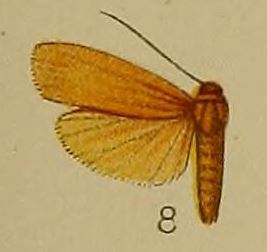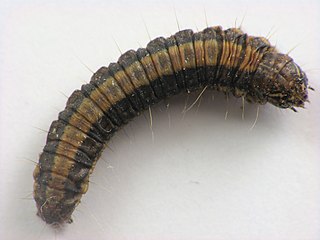
Crambinae is a large subfamily of the lepidopteran family Crambidae, the crambid snout moths. It currently includes over 1,800 species worldwide. The larvae are root feeders or stem borers, mostly on grasses. A few species are pests of sod grasses, maize, sugar cane, rice, and other Poaceae. The monophyly of this group is supported by the structure of the tympanal organs and the phallus attached medially to the juxta.

Brunia is a genus of tiger moths in the family Erebidae. The genus was described by Moore in 1878.
Leucotmemis is a genus of moths in the subfamily Arctiinae. The genus was erected by Arthur Gardiner Butler in 1876.
Liopasia is a genus of moths of the family Crambidae.

Streblote is a genus of moths in the family Lasiocampidae. It was described by Jacob Hübner in 1820.

Myopa is a genus of flies from the family Conopidae.

Brunia antica is a moth of the family Erebidae described by Francis Walker in 1854. It is found from the Indian subregion, Sri Lanka to China, the Ryukyu Islands, the Chagos Archipelago, the Nicobar Islands and Sundaland.

The Chrysauginae are a subfamily of snout moths. They are primarily Neotropical and include about 400 described species.

The Epipaschiinae are a subfamily of snout moths. Almost 600 species are known today, which are found mainly in the tropics and subtropics. Some occur in temperate regions, but the subfamily is apparently completely absent from Europe, at least as native species. A few Epipaschiinae are crop pests that may occasionally become economically significant.

Agostino Brunias was a London-based Italian painter from Rome. Strongly associated with West Indian art, he left England at the height of his career to chronicle Dominica and the neighboring islands of the Lesser Antilles.
Abacetus dorsalis is a species of ground beetle in the subfamily Pterostichinae. It was described by Viktor Motschulsky in 1866.
Brunia apicalis is a moth of the family Erebidae. It was described by Francis Walker in 1862. It is found on Borneo. The habitat consists of forests, ranging from lowlands to 1,200 meters.
Ovenna vicaria, the ubiquitous footman, is a moth of the subfamily Arctiinae. It was described by Francis Walker in 1854. It is found in Africa, where it has been recorded from Angola, Cameroon, the Republic of the Congo, the Democratic Republic of the Congo, Guinea, Lesotho, Malawi, Mozambique, Nigeria, South Africa, Uganda and Zambia. Records from the Oriental region refer to Brunia antica.
Popoudina dorsalis is a moth of the family Erebidae. It was described by Francis Walker in 1855. It is found in South Africa.
Leucotmemis dorsalis is a moth of the subfamily Arctiinae. It was described by Francis Walker in 1854. It is found in the Amazon region.
Streblote dorsalis is a moth of the family Lasiocampidae first described by Francis Walker in 1866. It is found in India, Sri Lanka, the Philippines, Borneo, Indonesia and Java.

Hedriodiscus is a genus of soldier flies in the family Stratiomyidae. There are more than 20 described species in Hedriodiscus.








